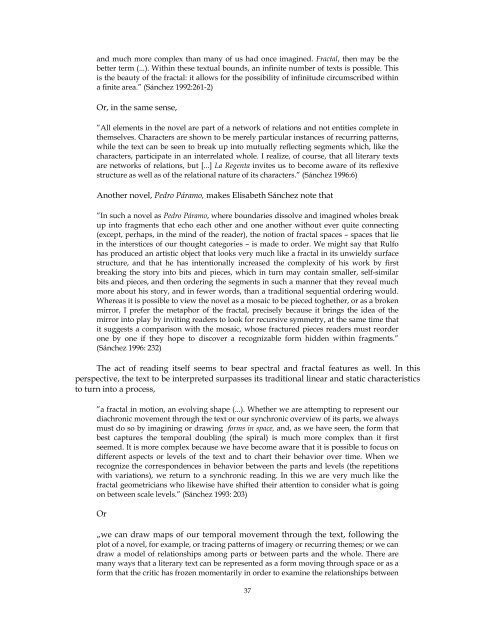Create successful ePaper yourself
Turn your PDF publications into a flip-book with our unique Google optimized e-Paper software.
and much more complex than many of us had once imagined. Fractal, then may be the<br />
better term (...). Within these <strong>text</strong>ual bounds, an infinite number of <strong>text</strong>s is possible. This<br />
is the beauty of the fractal: it allows for the possibility of infinitu<strong>de</strong> circumscribed within<br />
a finite area.” (Sánchez 1992:261-2)<br />
Or, in the same sense,<br />
”All elements in the novel are part of a network of relations and not entities complete in<br />
themselves. Characters are shown to be merely particular instances of recurring patterns,<br />
while the <strong>text</strong> can be seen to break up into mutually reflecting segments which, like the<br />
characters, participate in an interrelated whole. I realize, of course, that all literary <strong>text</strong>s<br />
are networks of relations, but [...] La Regenta invites us to become aware of its reflexive<br />
structure as well as of the relational nature of its characters.” (Sánchez 1996:6)<br />
Another novel, Pedro Páramo, makes Elisabeth Sánchez note that<br />
”In such a novel as Pedro Páramo, where boundaries dissolve and imagined wholes break<br />
up into fragments that echo each other and one another without ever quite connecting<br />
(except, perhaps, in the mind of the rea<strong>de</strong>r), the notion of fractal spaces – spaces that lie<br />
in the interstices of our thought categories – is ma<strong>de</strong> to or<strong>de</strong>r. We might say that Rulfo<br />
has produced an artistic object that looks very much like a fractal in its unwieldy surface<br />
structure, and that he has intentionally increased the complexity of his work by first<br />
breaking the story into bits and pieces, which in turn may contain smaller, self-similar<br />
bits and pieces, and then or<strong>de</strong>ring the segments in such a manner that they reveal much<br />
more about his story, and in fewer words, than a traditional sequential or<strong>de</strong>ring would.<br />
Whereas it is possible to view the novel as a mosaic to be pieced toghether, or as a broken<br />
mirror, I prefer the metaphor of the fractal, precisely because it brings the i<strong>de</strong>a of the<br />
mirror into play by inviting rea<strong>de</strong>rs to look for recursive symmetry, at the same time that<br />
it suggests a comparison with the mosaic, whose fractured pieces rea<strong>de</strong>rs must reor<strong>de</strong>r<br />
one by one if they hope to discover a recognizable form hid<strong>de</strong>n within fragments.”<br />
(Sánchez 1996: 232)<br />
The act of reading itself seems to bear spectral and fractal features as well. In this<br />
perspective, the <strong>text</strong> to be interpreted surpasses its traditional linear and static characteristics<br />
to turn into a process,<br />
”a fractal in motion, an evolving shape (...). Whether we are attempting to represent our<br />
diachronic movement through the <strong>text</strong> or our synchronic overview of its parts, we always<br />
must do so by imagining or drawing forms in space, and, as we have seen, the form that<br />
best captures the temporal doubling (the spiral) is much more complex than it first<br />
seemed. It is more complex because we have become aware that it is possible to focus on<br />
different aspects or levels of the <strong>text</strong> and to chart their behavior over time. When we<br />
recognize the correspon<strong>de</strong>nces in behavior between the parts and levels (the repetitions<br />
with variations), we return to a synchronic reading. In this we are very much like the<br />
fractal geometricians who likewise have shifted their attention to consi<strong>de</strong>r what is going<br />
on between scale levels.” (Sánchez 1993: 203)<br />
Or<br />
„we can draw maps of our temporal movement through the <strong>text</strong>, following the<br />
plot of a novel, for example, or tracing patterns of imagery or recurring themes; or we can<br />
draw a mo<strong>de</strong>l of relationships among parts or between parts and the whole. There are<br />
many ways that a literary <strong>text</strong> can be represented as a form moving through space or as a<br />
form that the critic has frozen momentarily in or<strong>de</strong>r to examine the relationships between<br />
37












